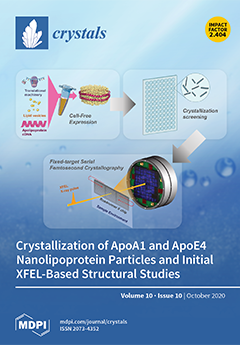(
E)-1-(1
H-Benzo[
d]imidazol-2-yl)-3-(dimethylamino)prop-2-en-1-one
2 was synthesized by one-pot synthesis protocol of 2-acetyl benzo[
d]imidazole with dimethylformamide dimethylacetal (DMF-DMA) in xylene at 140 °C for 8 h. Reaction of enaminone derivative
1 with acetylacetone in the presence of AcOH/NH
[...] Read more.
(
E)-1-(1
H-Benzo[
d]imidazol-2-yl)-3-(dimethylamino)prop-2-en-1-one
2 was synthesized by one-pot synthesis protocol of 2-acetyl benzo[
d]imidazole with dimethylformamide dimethylacetal (DMF-DMA) in xylene at 140 °C for 8 h. Reaction of enaminone derivative
1 with acetylacetone in the presence of AcOH/NH
4OAc under reflux afforded the cyclized pyridino-benzo[
d]imidazole derivative
3. The latter compound was converted into the corresponding
β-enaminone
4 with DMF-DMA. The single crystal X-ray diffraction technique eventually confirmed the assigned chemical structure of the
N-alkyl-
β-enaminone
2 and pyridino-benzo[
d]imidazole derivative
3.
N-alkyl-
β-enaminone
2 crystallized in the monoclinic space group P2
1/n with unit cell parameters of
a = 9.8953(3) Å,
b = 5.7545(2) Å,
c = 21.7891(7) Å, and β =100.627(2)°, and with one molecule per asymmetric unit. On the other hand, compound
3 crystallized in the orthorhombic crystal system and space group P2
12
12
1 with unit cell parameters of
a = 6.82950(10) Å,
b = 8.00540(10) Å,
c = 22.4779(2) Å, and also with one molecule per asymmetric unit. Based on Hirshfeld analysis, the H...H (51.3%), O...H (10.0%), N...H (10.3%), and C...H (27.6%) contacts in
2 and the H...H (46.8%), O...H (9.9%), N...H (13.0%), and C...H (21.6%) in addition to the C…C (6.7%) interactions in
3 are the most important towards crystal stability via molecular packing. The main difference is the presence of π–π interaction among the molecular units of
3 but not in
2. The calculated
1H and
13C NMR chemical shifts showed good agreements with experimental data. Electronic properties and reactivity parameters of both compounds are also calculated and compared.
Full article





